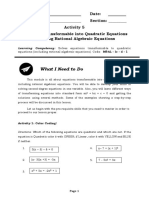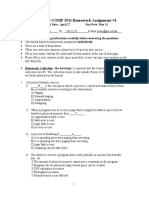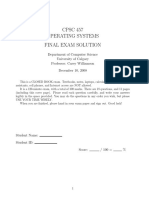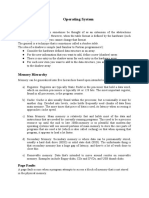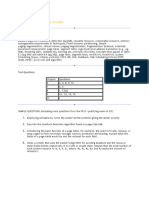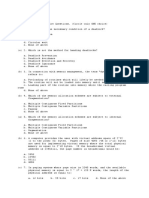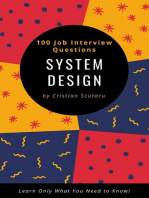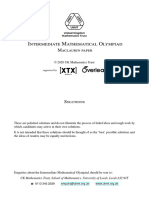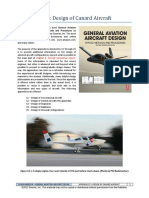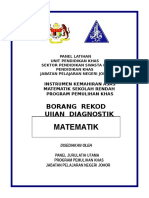Os + Ds
Os + Ds
Uploaded by
Aniket AggarwalCopyright:
Available Formats
Os + Ds
Os + Ds
Uploaded by
Aniket AggarwalOriginal Title
Copyright
Available Formats
Share this document
Did you find this document useful?
Is this content inappropriate?
Copyright:
Available Formats
Os + Ds
Os + Ds
Uploaded by
Aniket AggarwalCopyright:
Available Formats
Operating Systems | Set 5 March 12, 2012 Following questions have been asked in GATE 2012 exam. 1.
A process executes the code fork (); fork (); fork (); The total number of child processes created is (A) 3 (B) 4 (C) 7 (D) 8 Answer (C) Let us put some label names for the three lines fork (); // Line 1 fork (); // Line 2 fork (); // Line 3 L1 // There will be 1 child process created by line 1 / \ L2 L2 // There will be 2 child processes created by line 2 / \ / \ L3 L3 L3 L3 // There will be 4 child processes created by line 3 We can also use direct formula to get the number of child processes. With n fork statements, there are always 2^n 1 child processes. Also see this post for more details.
2. consider the 3 processes, P1, P2 and P3 shown in the table Process P1 P2 P3 Arrival time 0 1 3 Time unit required 5 7 4
The completion order of the 3 processes under the policies FCFS and RRS (round robin scheduling with CPU quantum of 2 time units) are (A) FCFS: P1, P2, P3 RR2: P1, P2, P3 (B) FCFS: P1, P3, P2 RR2: P1, P3, P2
(C) FCFS: P1, P2, P3 RR2: P1, P3, P2 (D) FCFS: P1, P3, P2 RR2: P1, P2, P3 Answer (C)
3. Consider the virtual page reference string 1, 2, 3, 2, 4, 1, 3, 2, 4, 1 On a demand paged virtual memory system running on a computer system that main memory size of 3 pages frames which are initially empty. Let LRU, FIFO and OPTIMAL denote the number of page faults under the corresponding page replacements policy. Then (A) OPTIMAL < LRU < FIFO (B) OPTIMAL < FIFO < LRU (C) OPTIMAL = LRU (D) OPTIMAL = FIFO Answer (B) The OPTIMAL will be 5, FIFO 6 and LRU 9.
4. A file system with 300 GByte uses a file descriptor with 8 direct block address. 1 indirect block address and 1 doubly indirect block address. The size of each disk block is 128 Bytes and the size of each disk block address is 8 Bytes. The maximum possible file size in this file system is (A) 3 Kbytes (B) 35 Kbytes (C) 280 Bytes (D) Dependent on the size of the disk Answer (B) Total number of possible addresses stored in a disk block = 128/8 = 16 Maximum number of addressable bytes due to direct address block = 8*128 Maximum number of addressable bytes due to 1 single indirect address block = 16*128 Maximum number of addressable bytes due to 1 double indirect address block = 16*16*128 The maximum possible file size = 8*128 + 16*128 + 16*16*128 = 35KB 1. Using a larger block size in a fixed block size file system leads to (GATE CS 2003) a) better disk throughput but poorer disk space utilization b) better disk throughput and better disk space utilization c) poorer disk throughput but better disk space utilization d) poorer disk throughput and poorer disk space utilization Answer (a) If block size is large then seek time is less (fewer blocks to seek) and disk performance is improved, but remember larger block size also causes waste of disk space.
2. Consider the following statements with respect to user-level threads and kernel supported threads i. context switch is faster with kernel-supported threads ii. for user-level threads, a system call can block the entire process iii. Kernel supported threads can be scheduled independently iv. User level threads are transparent to the kernel Which of the above statements are true? (GATE CS 2004) a) (ii), (iii) and (iv) only b) (ii) and (iii) only c) (i) and (iii) only d) (i) and (ii) only Answer(a) http://en.wikipedia.org/wiki/Thread_%28computer_science%29 3. The minimum number of page frames that must be allocated to a running process in a virtual memory environment is determined by (GATE CS 2004) a) the instruction set architecture b) page size c) physical memory size d) number of processes in memory Answer (a) Each process needs minimum number of pages based on instruction set architecture. Example IBM 370: 6 pages to handle MVC (storage to storage move) instruction Instruction is 6 bytes, might span 2 pages. 2 pages to handle from. 2 pages to handle to. 4. In a system with 32 bit virtual addresses and 1 KB page size, use of one-level page tables for virtual to physical address translation is not practical because of (GATE CS 2003) a) the large amount of internal fragmentation b) the large amount of external fragmentation c) the large memory overhead in maintaining page tables d) the large computation overhead in the translation process Answer (c) Since page size is too small it will make size of page tables huge. Size of page table = (total number of page table entries) *(size of a page table entry) Let us see how many entries are there in page table Number of entries in page table = (virtual address space size)/(page size) = (2^32)/(2^10)
= 2^22 Now, let us see how big each entry is. If size of physical memory is 512 MB then number of bits required to address a byte in 512 MB is 29. So, there will be (512MB)/(1KB) = (2^29)/(2^10) page frames in physical memory. To address a page frame 19 bits are required. Therefore, each entry in page table is required to have 19 bits. Note that page table entry also holds auxiliary information about the page such as a present bit, a dirty or modified bit, address space or process ID information, amongst others. So size of page table > (total number of page table entries) *(size of a page table entry) > (2^22 *19) bytes > 9.5 MB And this much memory is required for each process because each process maintains its own page table. Also, size of page table will be more for physical memory more than 512MB. Therefore, it is advised to use multilevel page table for such scenarios. 1. Suppose the time to service a page fault is on the average 10 milliseconds, while a memory access takes 1 microsecond. Then a 99.99% hit ratio results in average memory access time of (GATE CS 2000) (a) 1.9999 milliseconds (b) 1 millisecond (c) 9.999 microseconds (d) 1.9999 microseconds Answer: (d) Explanation: Average memory access time = [(% of page miss)*(time to service a page fault) + (% of page hit)*(memory access time)]/100 So, average memory access time in microseconds is. (99.99*1 + 0.01*10*1000)/100 = (99.99+100)/1000 = 199.99/1000 =1.9999 s 2. Which of the following need not necessarily be saved on a context switch between processes? (GATE CS 2000) (a) General purpose registers (b) Translation look-aside buffer (c) Program counter (d) All of the above Answer: (d) Explanation: In a process context switch, the state of the first process must be saved somehow, so that, when the scheduler gets back to the execution of the first process, it can restore this state and continue.
The state of the process includes all the registers that the process may be using, especially the program counter, plus any other operating system specific data that may be necessary. A Translation lookaside buffer (TLB) is a CPU cache that memory management hardware uses to improve virtual address translation speed. A TLB has a fixed number of slots that contain page table entries, which map virtual addresses to physical addresses. On a context switch, some TLB entries can become invalid, since for example the previously running process had access to a page, but the process to run does not. References: http://en.wikipedia.org/wiki/Context_switch http://en.wikipedia.org/wiki/Translation_lookaside_buffer#Context_switch 3. Where does the swap space reside ? (GATE 2001) (a) RAM (b) Disk (c) ROM (d) On-chip cache Answer: (b) Explanation: Swap space is an area on disk that temporarily holds a process memory image. When physical memory demand is sufficiently low, process memory images are brought back into physical memory from the swap area. Having sufficient swap space enables the system to keep some physical memory free at all times. References: http://docs.hp.com/en/B2355-90672/ch06s02.html 4. Which of the following does not interrupt a running process? (GATE CS 2001) (a) A device (b) Timer (c) Scheduler process (d) Power failure Answer: (c) Explanation: Scheduler process doesnt interrupt any process, its Job is to select the processes for following three purposes. Long-term scheduler(or job scheduler) selects which processes should be brought into the ready queue Short-term scheduler(or CPU scheduler) selects which process should be executed next and allocates CPU. Mid-term Scheduler (Swapper)- present in all systems with virtual memory, temporarily removes processes from main memory and places them on secondary memory (such as a disk drive) or vice versa. The mid-term scheduler may decide to swap out a process which has not been active for some time, or a process which has a low priority, or a process which is page faulting frequently, or a process which is taking up a large amount of memory in order to free up main memory for other processes, swapping the process back in later when more memory is available, or when the process has been unblocked and is no longer waiting for a resource.
5. Which of the following scheduling algorithms is non-preemptive? (GATE CS 2002) a) Round Robin b) First-In First-Out c) Multilevel Queue Scheduling d) Multilevel Queue Scheduling with Feedback Answer: (b) 1. Which of the following is NOT a valid deadlock prevention scheme? (GATE CS 2000) (a) Release all resources before requesting a new resource (b) Number the resources uniquely and never request a lower numbered resource than the last one requested. (c) Never request a resource after releasing any resource (d) Request and all required resources be allocated before execution. Answer: (c) References: http://www.cs.jhu.edu/~yairamir/cs418/os4/sld013.htm http://en.wikipedia.org/wiki/Deadlock 2. Let m[0]m[4] be mutexes (binary semaphores) and P[0] . P[4] be processes. Suppose each process P[i] executes the following: wait (m[i]); wait(m[(i+1) mode 4]); -----release (m[i]); release (m[(i+1)mod 4]); This could cause (GATE CS 2000) (a) Thrashing (b) Deadlock (c) Starvation, but not deadlock (d) None of the above Answer: (b) Explanation: You can easily see a deadlock in a situation where.. P[0] has acquired m[0] and waiting for m[1] P[1] has acquired m[1] and waiting for m[2] P[2] has acquired m[2] and waiting for m[3] P[3] has acquired m[3] and waiting for m[0] 3. A graphics card has on board memory of 1 MB. Which of the following modes can the card not support? (GATE CS 2000) (a) 1600 x 400 resolution with 256 colours on a 17 inch monitor
(b) 1600 x 400 resolution with 16 million colours on a 14 inch monitor (c) 800 x 400 resolution with 16 million colours on a 17 inch monitor (d) 800 x 800 resolution with 256 colours on a 14 inch monitor Answer: (b) Explanation: Monitor size doesnt matter here. So, we can easily deduct that answer should be (b) as this has the highest memory requirements. Let us verify it. Number of bits required to store a 16M colors pixel = ceil(log2(16*1000000)) = 24 Number of bytes required for 1600 x 400 resolution with 16M colors = (1600 * 400 * 24)/8 which is 192000000 (greater than 1MB). 4 Consider a virtual memory system with FIFO page replacement policy. For an arbitrary page access pattern, increasing the number of page frames in main memory will (GATE CS 2001) a) Always decrease the number of page faults b) Always increase the number of page faults c) Some times increase the number of page faults d) Never affect the number of page faults Answer: (c) Explanation: Incrementing the number of page frames doesnt always decrease the page faults (Beladys Anomaly). For details see http://en.wikipedia.org/wiki/Belady%27s_anomaly 5. Which of the following requires a device driver? (GATE CS 2001) a) Register b) Cache c) Main memory d) Disk Answer: (d) 1. Which of the following is NOT a valid deadlock prevention scheme? (GATE CS 2000) (a) Release all resources before requesting a new resource (b) Number the resources uniquely and never request a lower numbered resource than the last one requested. (c) Never request a resource after releasing any resource (d) Request and all required resources be allocated before execution. Answer: (c) References: http://www.cs.jhu.edu/~yairamir/cs418/os4/sld013.htm http://en.wikipedia.org/wiki/Deadlock 2. Let m[0]m[4] be mutexes (binary semaphores) and P[0] . P[4] be processes. Suppose each process P[i] executes the following:
wait (m[i]); wait(m[(i+1) mode 4]); -----release (m[i]); release (m[(i+1)mod 4]); This could cause (GATE CS 2000) (a) Thrashing (b) Deadlock (c) Starvation, but not deadlock (d) None of the above Answer: (b) Explanation: You can easily see a deadlock in a situation where.. P[0] has acquired m[0] and waiting for m[1] P[1] has acquired m[1] and waiting for m[2] P[2] has acquired m[2] and waiting for m[3] P[3] has acquired m[3] and waiting for m[0] 3. A graphics card has on board memory of 1 MB. Which of the following modes can the card not support? (GATE CS 2000) (a) 1600 x 400 resolution with 256 colours on a 17 inch monitor (b) 1600 x 400 resolution with 16 million colours on a 14 inch monitor (c) 800 x 400 resolution with 16 million colours on a 17 inch monitor (d) 800 x 800 resolution with 256 colours on a 14 inch monitor Answer: (b) Explanation: Monitor size doesnt matter here. So, we can easily deduct that answer should be (b) as this has the highest memory requirements. Let us verify it. Number of bits required to store a 16M colors pixel = ceil(log2(16*1000000)) = 24 Number of bytes required for 1600 x 400 resolution with 16M colors = (1600 * 400 * 24)/8 which is 192000000 (greater than 1MB). 4 Consider a virtual memory system with FIFO page replacement policy. For an arbitrary page access pattern, increasing the number of page frames in main memory will (GATE CS 2001) a) Always decrease the number of page faults b) Always increase the number of page faults c) Some times increase the number of page faults d) Never affect the number of page faults Answer: (c) Explanation:
5. Which of the following requires a device driver? (GATE CS 2001)
a) Register b) Cache c) Main memory d) Disk Answer: (d) Data structures 1) The recurrence relation capturing the optimal time of the Tower of Hanoi problem with n discs is (A) T(n) = 2T(n 2) + 2 (B) T(n) = 2T(n 1) + n (C) T(n) = 2T(n/2) + 1 (D) T(n) = 2T(n 1) + 1 Answer (D) 2) Consider the directed graph shown in the figure below. There are multiple shortest paths between vertices S and T. Which one will be reported by Dijstra?s shortest path algorithm? Assume that, in any iteration, the shortest path to a vertex v is updated only when a strictly shorter path to v is discovered.
(A) SDT (B) SBDT (C) SACDT (D) SACET Answer (D) 3) Suppose a circular queue of capacity (n 1) elements is implemented with an array of n elements. Assume that the insertion and deletion operation are carried out using REAR and FRONT as array index variables, respectively. Initially, REAR = FRONT = 0. The conditions to
detect queue full and queue empty are (A) Full: (REAR+1) mod n == FRONT, empty: REAR == FRONT (B) Full: (REAR+1) mod n == FRONT, empty: (FRONT+1) mod n == REAR (C) Full: REAR == FRONT, empty: (REAR+1) mod n == FRONT (D) Full: (FRONT+1) mod n == REAR, empty: REAR == FRONT Answer (A) 2. Consider the label sequences obtained by the following pairs of traversals on a labeled binary tree. Which of these pairs identify a tree uniquely (GATE CS 2004)? i) preorder and postorder ii) inorder and postorder iii) preorder and inorder iv) level order and postorder a) (i) only b) (ii), (iii) c) (iii) only d) (iv) only Answer (b) 3. The following numbers are inserted into an empty binary search tree in the given order: 10, 1, 3, 5, 15, 12, 16. What is the height of the binary search tree (the height is the maximum distance of a leaf node from the root)? (GATE CS 2004) a) 2 b) 3 c) 4 d) 6 Answer(b) 4. A data structure is required for storing a set of integers such that each of the following operations can be done in (log n) time, where n is the number of elements in the set. o o Delection of the smallest element Insertion of an element if it is not already present in the set
Which of the following data structures can be used for this purpose? (a) A heap can be used but not a balanced binary search tree (b) A balanced binary search tree can be used but not a heap (c) Both balanced binary search tree and heap can be used (d) Neither balanced binary search tree nor heap can be used Answer(b) A self-balancing balancing binary search tree containing n items allows the lookup, insertion, and removal of an item in O(log n) worst-case time. Since its a BST, we can easily find out minimum element in O(nlogn). See our post http://geeksforgeeks.org/?p=1333 for details.
Since Heap is a balanced binary tree (or almost complete binary tree), insertion complexity for heap is O(logn). Also complexity to get minimum in a min heap is O(logn) because removal of root node causes a call to heapify (after removing the first element from the array) to maintain the heap tree property. But a heap cannot be used for the above purpose as the question says insert an element if it is not already present. For a heap, we cannot find out in O(logn) if an element is present or not. Thanks to game for providing the correct solution. 5. A circularly linked list is used to represent a Queue. A single variable p is used to access the Queue. To which node should p point such that both the operations enQueue and deQueue can be performed in constant time? (GATE 2004)
a) rear node b) front node c) not possible with a single pointer d) node next to front Answer(a) Answer is not (b) front node, as we can not get rear from front in O(1), but if p is rear we can implement both enQueue and deQueue in O(1) because from rear we can get front in O(1). Below are sample functions. Note that these functions are just sample are not working. Code to handle base cases is missing. 2. Consider the Quicksort algorithm. Suppose there is a procedure for finding a pivot element which splits the list into two sub-lists each of which contains at least one-fifth of the elements. Let T(n) be the number of comparisons required to sort n elements. Then (A) T(n) <= 2T(n/5) + n (B) T(n) <= T(n/5) + T(4n/5) + n (C) T(n) <= 2T(4n/5) + n (D) T(n) <= 2T(n/2) + n Answer (C) For the case where n/5 elements are in one subset, T(n/5) comparisons are needed for the first subset with n/5 elements, T(4n/5) is for the rest 4n/5 elements, and n is for finding the pivot. If there are more than n/5 elements in one set then other set will have less than 4n/5 elements and time complexity will be less than T(n/5) + T(4n/5) + n because recursion tree will be more balanced.
3 Dijkstras single source shortest path algorithm when run from vertex a in the below graph, computes the correct shortest path distance to
(A) only vertex a (B) only vertices a, e, f, g, h (C) only vertices a, b, c, d (D) all the vertices Answer (D) http://www.geeksforgeeks.org/archives/4545
You might also like
- Activity Sheet Q1 Math 9 LC5Document14 pagesActivity Sheet Q1 Math 9 LC5MATHUTO100% (2)
- Discuss How The Following Pairs of Scheduling Criteria Conflict in Certain SettingsDocument13 pagesDiscuss How The Following Pairs of Scheduling Criteria Conflict in Certain SettingsSushma ShirodkarNo ratings yet
- I. Objectives: MarblesDocument4 pagesI. Objectives: Marblesjennifer sayong100% (1)
- Quantproblemset 1Document19 pagesQuantproblemset 1perxeptonNo ratings yet
- Operating System MCQS (GATE)Document40 pagesOperating System MCQS (GATE)Jitender Sharma75% (4)
- GATE QuestionsDocument90 pagesGATE Questionsas14jnNo ratings yet
- Operating SystemsDocument41 pagesOperating Systemstushu_hearthackerNo ratings yet
- Csci 4630 TestDocument14 pagesCsci 4630 Testbunty1836No ratings yet
- Comp3511 Spring16 hw4Document6 pagesComp3511 Spring16 hw4Wu DicksonNo ratings yet
- Os QuizDocument5 pagesOs QuizHem RameshNo ratings yet
- Free Flashcards About Stack #2087230Document3 pagesFree Flashcards About Stack #2087230Tonde PhiriNo ratings yet
- CPSC 457 Operating Systems Final Exam SolutionDocument11 pagesCPSC 457 Operating Systems Final Exam SolutionmuanaserNo ratings yet
- Computer OrganizationDocument26 pagesComputer Organizationmazhar kianiNo ratings yet
- Unit 5 OsDocument5 pagesUnit 5 OsPrashant JainNo ratings yet
- NumericalDocument9 pagesNumericalSK ANARULNo ratings yet
- Step 3 Test Chapter 8Document3 pagesStep 3 Test Chapter 8nicodzNo ratings yet
- Os QB1Document3 pagesOs QB1tt8534809022No ratings yet
- CS C372/IS C362 - Operating System: Birla Institute of Technology & Science, Pilani QUIZ 2 - Closed BookDocument2 pagesCS C372/IS C362 - Operating System: Birla Institute of Technology & Science, Pilani QUIZ 2 - Closed BookVishal MittalNo ratings yet
- OS - Numerical QuestionsDocument38 pagesOS - Numerical Questions18salonid2004No ratings yet
- 03-04 SoluionsDocument2 pages03-04 SoluionsAditya MittalNo ratings yet
- ÔN TẬP CUỐI MÔN OSDocument16 pagesÔN TẬP CUỐI MÔN OSNguyễn Bảo HưngNo ratings yet
- Assignment Unit 4Document18 pagesAssignment Unit 4Sachin KumarNo ratings yet
- Disk ManagementDocument27 pagesDisk ManagementramNo ratings yet
- CS C372/IS C362 - Operating System: Birla Institute of Technology & Science, Pilani QUIZ 3 - Closed BookDocument2 pagesCS C372/IS C362 - Operating System: Birla Institute of Technology & Science, Pilani QUIZ 3 - Closed BookVishal MittalNo ratings yet
- 作業系統HW2Document7 pages作業系統HW2Chia ChenNo ratings yet
- Coa 30Document101 pagesCoa 30Jobin LuckoseNo ratings yet
- Operating System Questions MCQDocument13 pagesOperating System Questions MCQSwetha D75% (4)
- Ops611s - Operating Systems - 2ND Opp - July 2022Document8 pagesOps611s - Operating Systems - 2ND Opp - July 2022Gerald KufangaNo ratings yet
- Question 1: MULTIPLE CHOICE QUESTIONS (20 Marks)Document11 pagesQuestion 1: MULTIPLE CHOICE QUESTIONS (20 Marks)aimen_riyadhNo ratings yet
- GlobalDocument9 pagesGlobaldildilliNo ratings yet
- MidtermsolutionsDocument3 pagesMidtermsolutionsRajini GuttiNo ratings yet
- CSF204 CS214 OS Garima End Garima Verma MDocument2 pagesCSF204 CS214 OS Garima End Garima Verma Mshivangi SinghNo ratings yet
- Example Problems: Thursday, 3 April 2003Document5 pagesExample Problems: Thursday, 3 April 2003MonicaP18No ratings yet
- Exam OS - Ready! PDFDocument8 pagesExam OS - Ready! PDFCaris TchobsiNo ratings yet
- Objective QA - EC 6009Document13 pagesObjective QA - EC 6009Santhanamari GNo ratings yet
- Correct Answer Is B)Document15 pagesCorrect Answer Is B)Vikas BansalNo ratings yet
- CS704 Finalterm QA Past PapersDocument20 pagesCS704 Finalterm QA Past PapersMuhammad MunirNo ratings yet
- Ecu Exam2 CSCI 4630 2012Document11 pagesEcu Exam2 CSCI 4630 2012bunty1836No ratings yet
- OS McqsDocument13 pagesOS Mcqsvedant bhatnagarNo ratings yet
- MidtermDocument2 pagesMidtermspanishsauceNo ratings yet
- Midterm PracticeDocument7 pagesMidterm PracticeZhang YoudanNo ratings yet
- Memory Manegment ch#7 Operating SystemDocument100 pagesMemory Manegment ch#7 Operating SystemFreke HuŠsyNo ratings yet
- NumericalupDocument9 pagesNumericalupSK ANARULNo ratings yet
- b2 Fat 2018 PDFDocument2 pagesb2 Fat 2018 PDFAhmed Shmels MuheNo ratings yet
- CS Operating-System PDFDocument20 pagesCS Operating-System PDFShubham SauravNo ratings yet
- Final Sample SolDocument12 pagesFinal Sample Solözlem ErdemNo ratings yet
- Final Exam O.SDocument5 pagesFinal Exam O.SmtelisoNo ratings yet
- Set No. 1Document7 pagesSet No. 1Dinesh Padma Rao KadiyamNo ratings yet
- MCQ On Operating System-All UnitDocument15 pagesMCQ On Operating System-All Unitprashant kumarNo ratings yet
- Maulana Azad National Institute of Technology, BhopalDocument2 pagesMaulana Azad National Institute of Technology, BhopalMaheshNo ratings yet
- MCQS (Operating System)Document17 pagesMCQS (Operating System)cfhdystjcogNo ratings yet
- Operating System (OS) OS Questions and Answers Set 1Document7 pagesOperating System (OS) OS Questions and Answers Set 1abi adamuNo ratings yet
- Memory ManagementDocument27 pagesMemory ManagementAbhishek DuttaNo ratings yet
- OS - Module Question BankDocument10 pagesOS - Module Question Bankhijan63967No ratings yet
- Operating System Questions and AnswerssDocument46 pagesOperating System Questions and AnswerssMichael PeterNo ratings yet
- Cs241fa09hw2 SolutionsDocument6 pagesCs241fa09hw2 SolutionsTiên BùiNo ratings yet
- midterm2023امتحان بنيةDocument4 pagesmidterm2023امتحان بنيةAhmed ElkerdawyNo ratings yet
- Exercises On Memory ManagementDocument3 pagesExercises On Memory ManagementLộc SẹoNo ratings yet
- hw1 RahulBaghel UIN627007808 PDFDocument4 pageshw1 RahulBaghel UIN627007808 PDFkp1032No ratings yet
- CS604 Operating Systems 2012 Final Term Questions Answers Solved With References by MoaazDocument15 pagesCS604 Operating Systems 2012 Final Term Questions Answers Solved With References by MoaazShahrukh UsmanNo ratings yet
- Exam OS 2 - Ready!Document5 pagesExam OS 2 - Ready!Caris Tchobsi100% (1)
- Final SolutionDocument8 pagesFinal SolutionArjun SehrawatNo ratings yet
- Validity and Reliability of MeasurementsDocument36 pagesValidity and Reliability of MeasurementsEtalem BurakoNo ratings yet
- UKMT - IMOK - Maclaurin - Intermediate Mathematical Olympiad and Kangaroo 2020 - SolutionsDocument8 pagesUKMT - IMOK - Maclaurin - Intermediate Mathematical Olympiad and Kangaroo 2020 - SolutionsArsh TewariNo ratings yet
- Lecture 7 Forced and Damped Oscillations PDFDocument3 pagesLecture 7 Forced and Damped Oscillations PDFSahaj ChhetriNo ratings yet
- Table Time Value of MoneyDocument10 pagesTable Time Value of MoneyNABILAH KHANSA 1911000089No ratings yet
- 16 Numerical Ability GATE ExpDocument26 pages16 Numerical Ability GATE ExpchandanNo ratings yet
- GO2 Iker-Summary ReportDocument19 pagesGO2 Iker-Summary ReporttxetxitoNo ratings yet
- Khee Poh Lam, Nyuk Hien Wong and Sekhar Chandra Department of Building, National University of Singapore, 4 Architecture Drive, Singapore 117566Document8 pagesKhee Poh Lam, Nyuk Hien Wong and Sekhar Chandra Department of Building, National University of Singapore, 4 Architecture Drive, Singapore 117566RinaldyNo ratings yet
- 1 Metrics IntroDocument5 pages1 Metrics IntroDmitri ZaitsevNo ratings yet
- Equations Letters Both Sides PDFDocument3 pagesEquations Letters Both Sides PDFSachin BetawarNo ratings yet
- 2021-Data-Driven Stuck Pipe Prediction and RemediesDocument9 pages2021-Data-Driven Stuck Pipe Prediction and Remediessobhan mohammadiNo ratings yet
- Matthew Morrow - Algebraic Number TheoryDocument63 pagesMatthew Morrow - Algebraic Number TheoryPang Lok WingNo ratings yet
- Pavlov Article On Debye Huckel TheoryDocument14 pagesPavlov Article On Debye Huckel Theoryarun rajaramNo ratings yet
- Widerange Speed Control Scheme of BLDC Motor Based On The Hall Sensor Signal PDFDocument9 pagesWiderange Speed Control Scheme of BLDC Motor Based On The Hall Sensor Signal PDFlongNo ratings yet
- Pre-Processing: Bageshree V. Sathe-Pathak, Ashish R. PanatDocument4 pagesPre-Processing: Bageshree V. Sathe-Pathak, Ashish R. PanatRukmani DeviNo ratings yet
- Compare DFS & BFS Graph TraversalsDocument6 pagesCompare DFS & BFS Graph TraversalsKartheeswari SaravananNo ratings yet
- 3.1 Geometry Toolkit - Hard - QPDocument4 pages3.1 Geometry Toolkit - Hard - QPMahendra ModiNo ratings yet
- 11 12 Week1 Math Geometry - FreeDocument21 pages11 12 Week1 Math Geometry - FreeRajesh PalNo ratings yet
- Linearsys Ecen 3300 SyllabusDocument3 pagesLinearsys Ecen 3300 SyllabusJoshua DusariNo ratings yet
- App-C2-Design of Canard Aircraft PDFDocument20 pagesApp-C2-Design of Canard Aircraft PDFWouter De GruijlNo ratings yet
- A Study of Simulation Methodology in Construction IndustryDocument4 pagesA Study of Simulation Methodology in Construction IndustryOscar llacchas floresNo ratings yet
- Extensions To The ICH Q1E Approach For The Statistical Evaluation of Stability Data For A Large Number of LotsDocument8 pagesExtensions To The ICH Q1E Approach For The Statistical Evaluation of Stability Data For A Large Number of Lotsqac gmp100% (1)
- Intervention Plan - Math 6 2022 2023Document3 pagesIntervention Plan - Math 6 2022 2023Chok MallareNo ratings yet
- Math7-Q1-W3-LAS-Lesson 1Document9 pagesMath7-Q1-W3-LAS-Lesson 1Amelita TupazNo ratings yet
- Ebook NSW Y9 Maths Year 9 5.1Document199 pagesEbook NSW Y9 Maths Year 9 5.1evarghhhNo ratings yet
- Borang Rekod Ujian Diagnostik MatematikDocument6 pagesBorang Rekod Ujian Diagnostik MatematikMahaziqah Farhah MahmudNo ratings yet
- Operations of Polynomials - Addition Subtraction Multiplication and Division of PolynomialsDocument40 pagesOperations of Polynomials - Addition Subtraction Multiplication and Division of PolynomialsKen Aisa G. OrtizNo ratings yet
- 15 Ball ScrewDocument488 pages15 Ball ScrewhelioNo ratings yet
